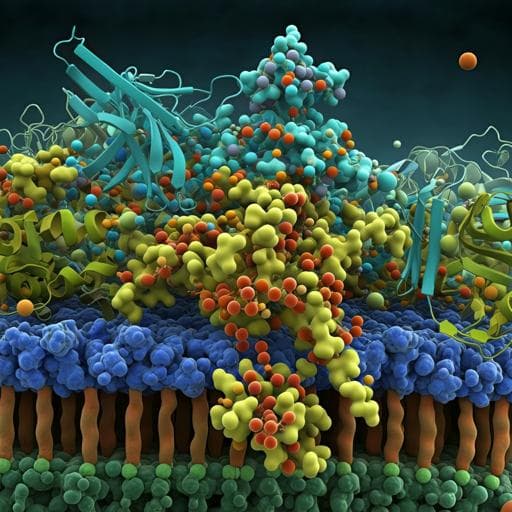
Medicine and Health
MFRP is a molecular hub that organizes the apical membrane of RPE cells by engaging in interactions with specific proteins and lipids
A. Tworak, R. Smidak, et al.
Discover how the absence of Membrane frizzled-related protein (MFRP) in the retinal pigment epithelium (RPE) leads to significant ocular issues like hyperopia and retinitis pigmentosa. This research, conducted by a team at the Gavin Herbert Eye Institute, unveils MFRP's critical role in retinal health and offers insight into potential gene therapy outcomes.
~3 min • Beginner • English
Introduction
The study investigates the molecular functions of membrane frizzled-related protein (MFRP), a type-II single-pass membrane protein expressed predominantly in the retinal pigment epithelium (RPE) and ciliary epithelium. Pathogenic variants in MFRP cause autosomal recessive nonsyndromic nanophthalmos with severe hyperopia and early-onset retinitis pigmentosa. Although gene therapy approaches have shown promise in preclinical models, the mechanisms by which MFRP supports retinal physiology remain unclear. MFRP localizes to the apical membrane of RPE cells, and its locus neighbors C1QTNF5, with which it can form complexes in vitro, but the biological significance of this interaction is unresolved. Prior work suggests functional links to adiponectin receptor 1 (ADIPOR1), with overlapping retinal lipid phenotypes in knockouts and loss of ADIPOR1 from the RPE apical membrane in MFRP deficiency. The central research questions are: what biochemical properties and interaction partners characterize MFRP, how does MFRP loss affect RPE and retinal lipid and retinoid homeostasis, and can gene therapy restore molecular defects caused by MFRP deficiency.
Literature Review
The authors situate their work within findings that MFRP mutations cause nanophthalmos and retinal degeneration, with previous reports showing MFRP’s apical RPE localization and colocalization with C1QTNF5. While bicistronic transcription with C1QTNF5 has been documented, each gene appears independently regulated and produces distinct disease phenotypes when mutated. Functional links to ADIPOR1 have been proposed, including shared PUFA abnormalities (notably DHA) and epistatic interactions in mouse models. Gene augmentation/editing approaches for MFRP have shown structural and functional rescue in mice, but mechanistic underpinnings remained elusive. This study builds on these observations to define MFRP glycosylation, lipid/protein-binding properties, and consequences of loss on visual cycle and lipid metabolism.
Methodology
- In silico analyses: Examined human and mouse MFRP/C1QTNF5 loci (ENCODE promoter/enhancer annotations) and tissue RNA-seq (GTEx); assessed alternative splicing of MFRP exon 2 in human donor eyes; predicted N- and O-glycosylation sites and an O-linked sugar (OLS) domain.
- Glycosylation assays: Deglycosylation of native bovine RPE membrane fractions with N-glycanase and O-glycosidase cocktails; SDS-PAGE mobility shifts quantified.
- Mouse models: rd6 (Mfrp) knockout mice on pigmented and albino backgrounds; AdipoR1 knockout mice; age-matched WT controls. ERG for scotopic function; retinal morphology and autofluorescence documented.
- Transcriptomics: RNA-seq of RPE from 1-month WT and rd6 mice; quantified 21,279 transcripts; differential expression (q<0.05, fold-change thresholds); gene set enrichment analysis (GO biological processes, KEGG pathways).
- Visual cycle biochemistry: Retinoid extraction and HPLC quantification of 11-cis-retinal, all-trans-retinal, all-trans-retinol, and retinyl esters in dark-adapted eyes and during dark recovery (0–20 h) after a bright light bleach across ages (1–6 months).
- Lipidomics: Untargeted MS-based profiling of free fatty acids (FFAs) in RPE-lined eyecups, retinas, and liver; comprehensive phospho- and sphingolipid profiling (PA, PS, PI, PE, PC, PG, lyso-forms, ceramides) in RPE-eyecups and isolated retinas; analyses of class composition, AA/DHA ratios, and species-level changes.
- Cell culture perturbations: Primary bovine RPE treated with excess DHA, EPA, or ALA; qPCR of ELOVL2, FADS2, ELOVL4.
- Protein biochemistry and interactomics: Production of recombinant human MFRP-1D4 and C1QTNF5-FLAG in mammalian cells; dot-blot lipid binding; PS- vs PC-opsonized bead pull-downs; SMA-copolymer solubilization of native bovine RPE membranes for affinity purification–mass spectrometry (AP-MS) of MFRP interactors; validation by co-immunoprecipitation of recombinant MFRP with ADIPOR1-FLAG and KCNJ13-FLAG.
- Imaging and ultrastructure: Immunohistochemistry on murine retina/RPE sections and flatmounts for MFRP, ADIPOR1, KCNJ13, ZO-1, GLUT1; light microscopy of RPE phagosomes at 15 min and 2 h after light onset; TEM of RPE–outer segment interfaces.
- Gene therapy rescue: Subretinal injection of lentivirus encoding WT MFRP into 1-month rd6 mice; co-injection of GFP AAV to assess transduction coverage; IHC analysis at 3 weeks for restoration of MFRP, ADIPOR1, and KCNJ13 localization; additional domain-deletion MFRP variants tested for ADIPOR1 localization rescue.
- Statistics: Shapiro–Wilk normality; unpaired t-tests or Mann–Whitney with multiple-comparison correction; one-/two-way ANOVA with Holm–Šídák post hoc; significance at P<0.05.
Key Findings
- MFRP glycosylation: Seven putative N-glycosylation sequons (five high-probability) and a juxtamembranous O-linked sugar (OLS) domain were identified in silico. Enzymatic deglycosylation of bovine RPE membranes caused a ~25 kDa mobility shift with N-glycanase and an additional ~3 kDa shift with O-glycan removal, consistent with extensive N- and O-glycosylation and an OLS domain.
- Phototransduction: At 1 month, rd6 mice showed reduced ERG amplitudes but identical normalized rod a-wave leading edge kinetics versus WT, indicating intact early phototransduction; at 6 months, rd6 displayed slower kinetics.
- RPE transcriptomics: Of 21,279 transcripts, 4.7% were upregulated and 2.3% downregulated (q<0.05). Strong upregulation of complement/coagulation cascade genes (e.g., Cfi, F9, C4b, C1qa; >16-fold). Downregulated pathways included visual chromophore regeneration and unsaturated fatty-acid biosynthesis. RPE65 and LRAT were ~2-fold down; MFSD2A was 4-fold down and ACSL6 1.85-fold down; COX8B was 5.3-fold up; ID2 (2.5-fold up) and THBS1 (2.35-fold up).
- Visual cycle: Dark-adapted 11-cis-retinal levels were consistently >2-fold lower in rd6 vs WT across 1–6 months, while retinyl esters were similar until 6 months. After bleaching, 11-cis-retinal regenerated ~2-fold slower in rd6, consistent with reduced RPE65; retinyl esters peaked earlier in rd6.
- FFA lipidomics: In RPE-eyecups, total saturated/MUFA/PUFA proportions were unchanged, but the n-6/n-3 PUFA ratio decreased ~2.8-fold due to significant DHA accumulation and reduced linoleic acid; osbond acid (22:5 n-6) also accumulated. In retinas, total PUFA content decreased with compensatory saturated FA increase and >3-fold increase in n-6/n-3 within PUFAs, with marked depletion of DHA and its n-3 precursors (24:5, 24:6); DHA decreased >7-fold (partly reflecting photoreceptor loss).
- Membrane lipidomics: RPE-eyecup class composition was stable, but AA/DHA ratio decreased; only PE(16:0/18:2) declined (3.1-fold). In retina, class composition was stable but AA/DHA ratio increased 3.3-fold. Di-DHA PI(22:6/22:6), PS(22:6/22:6), and PE(22:6/22:6) decreased ~195-fold, ~23-fold, and ~18-fold, respectively, far exceeding effects expected from ~1/3 photoreceptor loss. Several mono-DHA species decreased ≥2-fold; some non-n-3-enriched species increased (>10-fold), e.g., PS(22:1/22:6), PE(18:0/22:5), PS(20:3/22:4). Ceramides were unchanged.
- Causality with DHA: Supplementing primary bovine RPE with DHA or EPA downregulated ELOVL2 and FADS2, whereas ALA did not alter ELOVL2/ELOVL4, supporting that DHA accumulation can suppress PUFA-biosynthesis gene expression.
- Lipid binding: Recombinant MFRP bound phosphatidylserine (PS), cardiolipin, sulfatide, and PI(4)P in dot blots; C1QTNF5 preferentially bound PA and PIPs (PI(4)P, PI(4,5)P2, PI(3,4,5)P3), with minimal overlap. MFRP specifically precipitated with PS-opsonized, not PC-opsonized, beads.
- Phagocytosis: Light microscopy and TEM at peak phagocytic times showed comparable RPE phagosomes and engulfment of OS tips in WT and rd6, indicating MFRP is not required for OS phagocytosis.
- Protein interactome: SMA-based AP-MS from native bovine RPE membranes identified 26 proteins significantly enriched (≥2-fold, P<0.05) with anti-MFRP vs control; among the most abundant were ADIPOR1 and KCNJ13. Co-IP with recombinant proteins confirmed MFRP–ADIPOR1 and MFRP–KCNJ13 interactions.
- In vivo localization: In WT, ADIPOR1 localized to the RPE apical membrane; in rd6, ADIPOR1 was absent from this site and its total protein level was reduced, despite unchanged transcript levels, indicating posttranscriptional dependence on MFRP. KCNJ13 remained at the RPE–retina interface in rd6 but redistributed diffusely into apical microvilli; transcript and protein abundance were unchanged, suggesting MFRP constrains KCNJ13 to the apical membrane proper.
- Gene therapy rescue: Subretinal delivery of WT MFRP lentivirus to rd6 mice restored MFRP expression at the RPE apical membrane and normalized the subcellular localization of ADIPOR1 and KCNJ13. Multiple MFRP domain-deletion variants also restored ADIPOR1 apical localization, implying modular architecture and that interaction/trafficking determinants lie outside the deleted domains.
Discussion
The findings clarify MFRP’s role as a molecular organizer of the RPE apical membrane. Extensive glycosylation and a likely OLS domain place MFRP among glycoproteins that extend rigid, protease-resistant extracellular spacers, compatible with its apical clustering. MFRP’s specific binding to PS and PI(4)P suggests roles in membrane interactions and intracellular trafficking, potentially facilitating targeting of MFRP and cargo to the apical membrane via PI(4)P-mediated Golgi export. Interactome and in vivo evidence show that MFRP governs the subcellular localization and stability/trafficking of ADIPOR1 and the spatial confinement of KCNJ13. Loss of MFRP causes ADIPOR1 depletion from the apical membrane and reduced protein abundance, paralleling profound DHA handling defects—DHA accumulation in RPE and severe depletion of di-DHA phosphoglycerides in retina—mirroring phenotypes of AdipoR1 deficiency. Together, these support a model in which MFRP coordinates protein–lipid organization at the RPE apical surface, with downstream consequences for retinal lipid homeostasis and photoreceptor health. Despite robust complement activation and slowed visual cycle output (reduced 11-cis-retinal and slower regeneration), photoreceptor phagocytosis appears intact, indicating compartmentalized dysfunction. Gene therapy restoring MFRP expression rescues ADIPOR1 and KCNJ13 localization, underscoring therapeutic relevance and providing molecular biomarkers of rescue.
Conclusion
This work establishes MFRP as a heavily glycosylated apical RPE protein that functions as a molecular hub, binding specific lipids and interacting with key membrane proteins ADIPOR1 and KCNJ13 to organize the apical membrane and influence retinal lipid homeostasis. Loss of MFRP leads to DHA accumulation in RPE, severe depletion of di-DHA phosphoglycerides in retina, complement activation, and reduced visual cycle throughput, while sparing OS phagocytosis. Restoring MFRP via gene therapy normalizes ADIPOR1 and KCNJ13 localization, supporting ongoing therapeutic development. Future studies should dissect: (1) causal links between MFRP–ADIPOR1 interaction and the lipid phenotype; (2) the mechanistic role of MFRP’s lipid-binding (especially PI(4)P) in trafficking; (3) functional consequences of KCNJ13 redistribution; and (4) domain-level determinants governing MFRP interactions and apical targeting.
Limitations
- Use of the rd6 mouse model entails retinal degeneration that can secondarily alter lipid profiles, complicating separation of primary vs secondary effects. The authors mitigate this by analyzing RPE vs retina, liver controls, and 1-month time points but residual confounding remains.
- While MFRP–ADIPOR1 and MFRP–KCNJ13 interactions and localization dependencies are shown, direct causality linking the MFRP–ADIPOR1 interaction to the DHA/di-DHA lipid phenotype is not conclusively demonstrated.
- Lipid-binding assays were performed in vitro with recombinant proteins and lipid spots; the in vivo significance and affinity hierarchy of these interactions require further validation.
- Complement activation and immune responses are described transcriptomically; functional immune assays were not performed.
- ERG kinetics at later stages suggest phototransduction slowing, but detailed mechanistic links to lipidomic changes in photoreceptor membranes were not directly tested.
Related Publications
Explore these studies to deepen your understanding of the subject.







